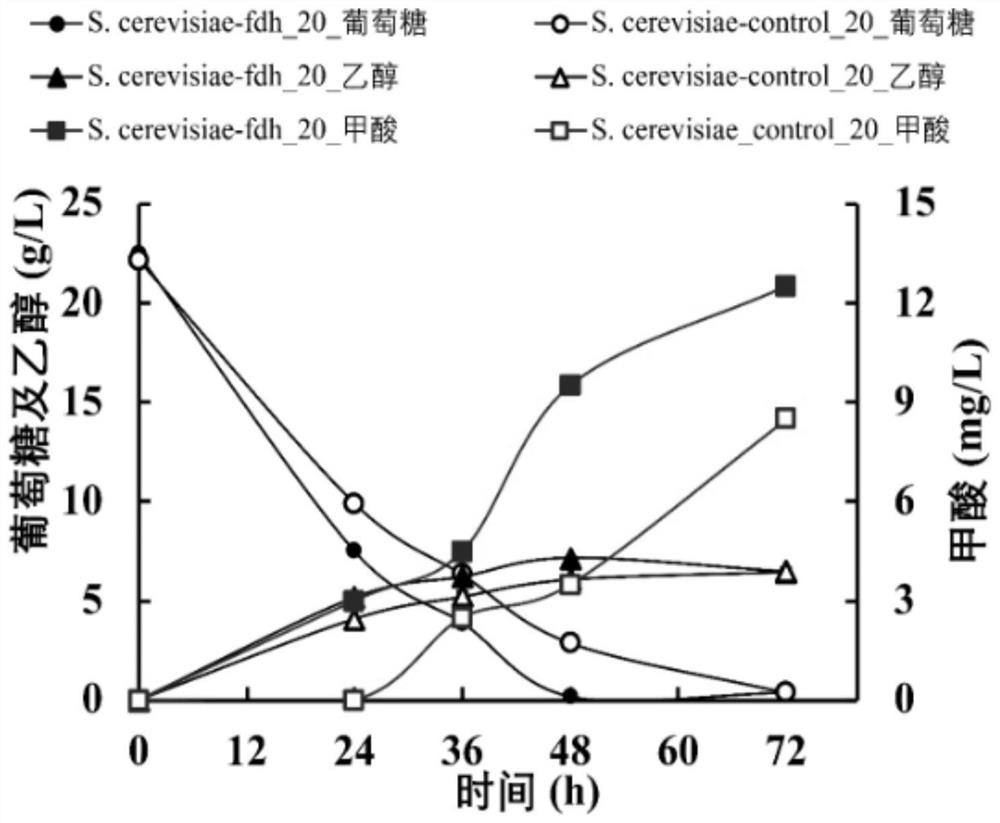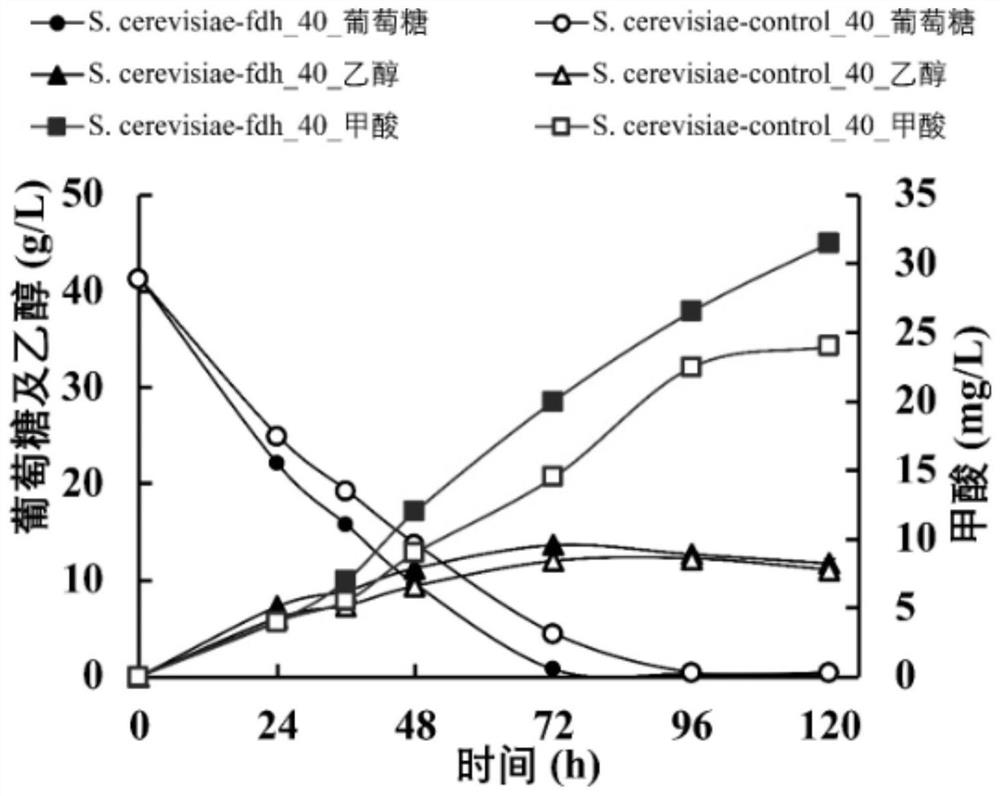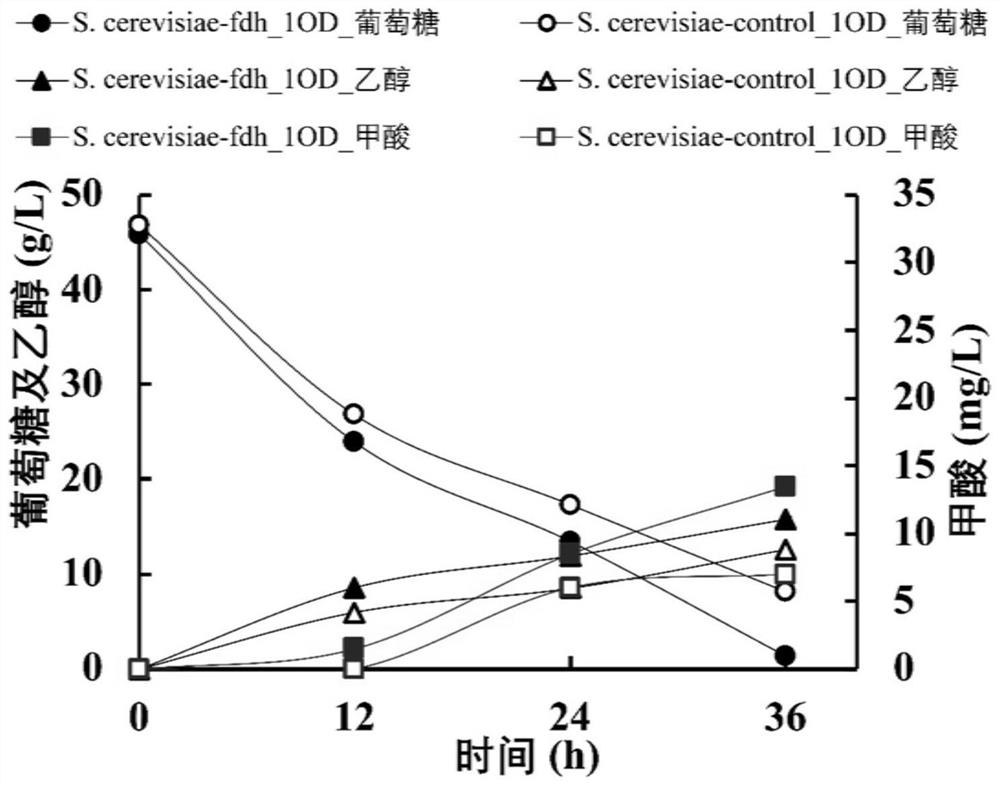Method for fixing carbon dioxide in situ in ethanol fermentation process
An ethanol fermentation and carbon dioxide technology, applied in the biological field, can solve the problem that carbon dioxide fixation efficiency needs to be further improved, and achieve the effects of improving carbon source utilization rate, speeding up fermentation rate, and improving ethanol yield
- Summary
- Abstract
- Description
- Claims
- Application Information
AI Technical Summary
Problems solved by technology
Method used
Image
Examples
Embodiment 1
[0024] Example 1: Construction of strain S. cerevisiae-FDH
[0025] The Fdh gene fragment was obtained by PCR amplification with the genome of Kluyveromyces marxianus as the template. The PCR amplification kit was HSDNA Polymerase (Code No.: R010A) purchased from Bao Bioengineering Dalian Co., Ltd. The PCR reaction was carried out according to the kit instructions . The PCR amplification conditions were denaturation at 99°C for 5 min, 98°C for 15s, 60°C for 15s, 72°C for 60s for 30 cycles, and extension at 72°C for 7 min. The obtained Fdh gene fragment was double-digested with restriction endonucleases Not I and Sal I, and then received On pRS424, the expression vector pRS424-FDH was obtained, and then transformed into Saccharomyces cerevisiae S288C to obtain the recombinant strain S.cerevisiae-FDH overexpressing formate dehydrogenase
Embodiment 2
[0026] Example 2: Fermentation effect and formic acid yield under 20g / L glucose
[0027] 1) Preparation of activation medium: activation medium: YNB 6.7 g / L, glucose 10 g / L, amino acid supplement solution without Trp.
[0028]2) Activation of strains: S. cerevisiae-FDH and the control strain S. cerevisiae S288C stored in the refrigerator were inoculated into the activation medium, placed in a shaker at 30° C. and cultured at 150 rpm for 48 hours.
[0029] 3) Preparation of seed medium: Seed medium: YNB 6.7 g / L, glucose 20 g / L, amino acid supplemented solution without Trp.
[0030] 4) In step 2), the activated bacterial cells were transferred to the seed medium prepared in step 3), placed in a shaker at 30° C. and cultured at 150 rpm for 48 hours.
[0031] 5) Preparation of fermentation medium: YNB 6.7 g / L, glucose 20 g / L, amino acid supplement solution without Trp.
[0032] 6) After the strains are activated and the seeds are expanded and cultured, the cells are collected by...
Embodiment 3
[0038] Example 3: Inoculum OD 620 Fermentation effect and formic acid yield under =1
[0039] 1) Preparation of activation medium: activation medium: YNB 6.7 g / L, glucose 10 g / L, amino acid supplement solution without Trp.
[0040] 2) Activation of strains: S. cerevisiae-FDH and the control strain S. cerevisiae S288C stored in the refrigerator were inoculated into the activation medium, placed in a shaker at 30° C. and cultured at 150 rpm for 48 hours.
[0041] 3) Preparation of seed medium: Seed medium: YNB 6.7 g / L, glucose 20 g / L, amino acid supplemented solution without Trp.
[0042] 4) In step 2), the activated bacterial cells were transferred to the seed medium prepared in step 3), placed in a shaker at 30° C. and cultured at 150 rpm for 48 hours.
[0043] 5) Preparation of fermentation medium: identification medium: YNB 6.7 g / L, glucose 40 g / L, amino acid supplement solution without Trp.
[0044] 6) After the strains are activated and the seeds are expanded and cultur...
PUM
 Login to View More
Login to View More Abstract
Description
Claims
Application Information
 Login to View More
Login to View More - R&D
- Intellectual Property
- Life Sciences
- Materials
- Tech Scout
- Unparalleled Data Quality
- Higher Quality Content
- 60% Fewer Hallucinations
Browse by: Latest US Patents, China's latest patents, Technical Efficacy Thesaurus, Application Domain, Technology Topic, Popular Technical Reports.
© 2025 PatSnap. All rights reserved.Legal|Privacy policy|Modern Slavery Act Transparency Statement|Sitemap|About US| Contact US: help@patsnap.com



